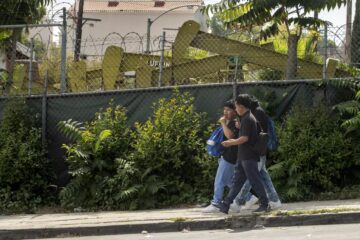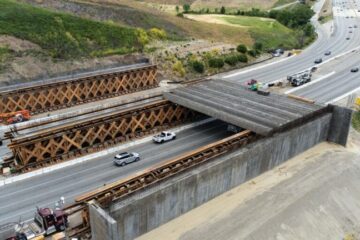Mammoth Area’s Beauty Masks Its Natural Dangers
Beneath the recreational paradise lies a seething volcanic underworld that tests officials’ efforts to safeguard residents and visitors.
Source of this article – Los Angeles Times, April 8, 2006.
By Usha Lee McFarling, Times Staff Writer
The deaths of three ski patrol members at Mammoth Mountain on Thursday highlight the many hazards facing those who live, work and play atop one of the nation’s largest active volcanic systems.
Earthquake swarms, toxic gases that are deadly when concentrated, the unlikely event of a cataclysmic eruption — such risks are permanent features of life in the exquisitely scenic area.
Geologists, public safely officials and resort managers do their best to protect residents and visitors from the dangers, but deaths do occasionally occur.
Eight years ago, a healthy 58-year-old man from Torrance, who was cross-country skiing in the nearby Horseshoe Lake area, was found dead. His death was believed to have resulted from breathing carbon dioxide gas, according to the Mono County coroner.
The fumes that emanate from volcanoes include the potentially lethal gases carbon dioxide and hydrogen sulfide, which gives the fumes their characteristic rotten-egg smell. Both are denser than air, so they tend to sink and pool in hollows where volcanic heat has melted the snow.
At the volcanic vent, or fumarole, where Thursday’s accident occurred, the emissions measured there in 2002 were 98% carbon dioxide and 0.005% hydrogen sulfide, said Dave Hill, a U.S. Geological Survey scientist who is in charge of the observatory in the Long Valley Caldera, the volcanic basin that includes the Mammoth area.
Though we exhale carbon dioxide and take in a small amount (0.03%) with each breath of fresh air, carbon dioxide levels of just 10% to 20% can be lethal. Hydrogen sulfide can be lethal in far lower amounts.
“At high concentrations, CO2 displaces oxygen from your lungs. At 70% or 80%, it just takes a couple of breaths,” Hill said. “People can expire very quickly.”
The areas that emit gases can shift as magma rearranges itself within the belly of a volcano, but they are relatively stable.
“Generally, the places with high gas output are known, but from time to time, new areas can develop,” said Jake Lowenstern, a geologist in charge of the volcanic observatory at Yellowstone National Park, the country’s largest active volcanic system.
 Partly because of Yellowstone’s flat topography near thermal areas and because of the area’s prevalent winds, there has been only one recorded death due to volcanic gases at the park, and that was in the 1930s.
Partly because of Yellowstone’s flat topography near thermal areas and because of the area’s prevalent winds, there has been only one recorded death due to volcanic gases at the park, and that was in the 1930s.
In the 1990s, large numbers of trees on the flanks of Mammoth Mountain near Horseshoe Lake began to die because large amounts of carbon dioxide were seeping from the volcano to the surface through the soil.
The dead trees now cover 170 acres and are less than two miles from where the accident occurred.
“Tree roots aren’t tolerant of CO2,” Hill said.
The largest area of dead trees, near Horseshoe Lake on the mountain’s south flank, is an eerie draw for visitors, who come to see the volcano at work. But posted warnings in the area are abundant, and the USGS hands out fact sheets that caution: “Do not lie face down on the ground anywhere near Horseshoe Lake or the tree-kill area.”
The area near Horseshoe Lake emits 50 to 150 tons of carbon dioxide per day — a large amount that has remained steady since the gas appeared in 1989. Thursday’s accident was mainly due to abnormally high snow conditions, geologists agreed.
“The vent has been there as long as people have been skiing on the mountain,” Hill said. “They’ve recognized it and tried to keep it fenced off. When snow accumulates gradually, it’s clear there’s a hole there. But when the snow accumulates really fast, you can’t keep track of where it is.”
Hill, who monitors the volcano remotely from USGS offices in Menlo Park, Calif., wears a pager that immediately warns him when any major activity occurs — a precursor to an eruption. Such signs can include earthquake swarms or ground swelling in the bottom of the caldera, which can rise when magma moves below it.
After a decade of stability, the caldera rose a foot between 1979 and 1980, following a swarm of earthquakes. It continued to rise steadily afterward and rose a total of 2.5 feet by 2000.
A massive eruption, though unlikely, remains a concern. When volcanoes in the chain running from Mammoth Mountain to Mono Lake blow, they can blow big. The last cataclysmic explosion, 760,000 years ago, flung 150 cubic miles of rock, dirt and ash from a hole four miles deep. Ash circled the globe and settled in thick layers as far away as Nebraska.
That explosion, 2,000 times larger than the 1980 eruption of Mt. St. Helens, created the Long Valley Caldera. It is a massive hole, 10 miles by two miles. Mammoth Mountain is a relatively young volcano, built by a series of eruptions between 220,000 and 50,000 years ago.
The USGS rates the likelihood of an eruption occurring in Long Valley at less than 1% in any given year. If one were to occur, Hill said, it would probably be a small one.
Small eruptions occurred as recently as the early 1800s in Mono Lake, he said. A rock formation in the lake is the remnant of an ancient volcano.
“Even a small eruption, depending on where the vent took place, could be a problem,” Hill said. Hill and his staff, working with public safety officials in Inyo and Mono counties, walk a delicate line. They try to keep people informed of dangers without alarming them. On a daily basis, they need to separate the volcano’s constant breathing and restlessness from any signs of imminent hazard. “You can have things that look really quite spooky and have it stop,” Hill said. “And if you trigger an evacuation and then it stops, that’s a catastrophe of another sort, in terms of economic damage and other things.”
Fortunately, large calderas generally give hints that they are about to erupt: earthquakes, buckling of the ground and burps of gas.
So far, such activity on the mountain remains quiet, or at least steady, helping ease any concerns among those who live nestled against the monster volcano.
“They’re dealing with it and living with it,” Hill said of area residents. “They actually take some comfort in the fact that we’re monitoring it.”


